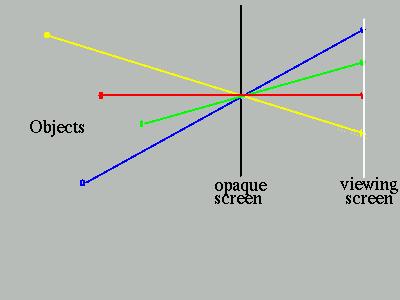
Light travels in straight lines. A small hole will select the light beams coming from different objects, and produce a fan of light that will make an image on a screen. This is a way to make a very simple "camera" that has no lens, called a pinhole camera. The sharpness of the image is limited by the size of the hole (smaller is better), as is the brightness of the image (larger is better). Compromises have to be made! A lens solves this problem by gathering all the light that hits it can redirecting it to one point -- but sometimes this creates new problems. Pinhole cameras were used by artists in the middle ages, who wanted to learn how to make more accurate representations of a scene; they are sometimes used to make images using Xrays and gamma rays (which are kinds of light for which it is hard to make a lens or a mirror); the eye of some kinds of molluscs is a pinhole camera (there is no lens).
I made a pinhole camera out of a 1 lb coffee can. I drilled the smallest hole I could through one side of the can, and then taped a piece of photographic film on the inside, opposite the hole. I covered the bottom of the can (which had been cut off, to get the coffee out) with a piece of aluminum foil, held in place by a rubber band. I covered the drilled hole with a square of black electrician's tape.
Modern photographic film is altogether too good! Even the tiniest leak of light will rapidly expose the film. The aluminum foil seal at the bottom should not have any big wrinkles. But the advantage is that the photograph only requires an exposure of a second or so. I placed the can so that the hole was aimed at a suitable scene, pulled off the tape, shouted "One!" and put the tape back on.
Here are some useful links about pinhole cameras:
Oatmeal box pinhole photography